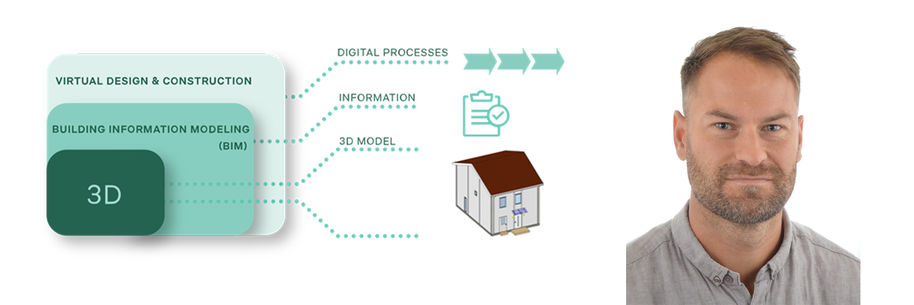Virtual Design and Construction from a Client Perspective

Bonava is a Nordic residential development company with roots dating back to the 1930s. With its 2,300 workforce, Bonava operates in Germany, Sweden, Finland, Denmark, Norway, St. Petersburg, Estonia and Latvia.
Digitalization and VDC are at the very core of Bonava’s strategy. It was, therefore, quite logical for the company to join as a consortium member in DiCtion, a project that aims to digitalize construction workflows. The Business Finland-funded R&D undertaking is led by Aalto University’s Department of Engineering and comprises nine organizations in total.
Leading on the path to digitalization
Sampo Oksama is the VDC (Virtual Design and Construction) manager at Bonava. After graduating with an M.Sc. in construction technology he worked as a BIM specialist at NCC. He then joined Trimble, where he became a consultant, helping designers and construction and manufacturing companies implement BIM.
“My experience from construction sites taught me that the same processes are repeated time after time, without any intent to improve them. That was the main reason for me navigating towards a development-oriented line of work,” Oksama notes.
Oksama says that starting as a lead for digitalization at Bonava almost three years ago was a natural career move, “a jump to the other side of the table” as he puts it. He saw DiCtion as a chance to speed up the company’s digitalization efforts and, as a result, to improve its construction productivity. His previous experiences with the consortium members further encouraged him to sign up Bonava for the project.

A digital transformation in the making
“As a client, when we start digitalizing our processes, we make a big impact on the whole construction supply chain. We contract designers, engage suppliers and subcontractors, and commission consultants and partners,” Oksama explains. “In DiCtion, our goal was to digitalize the process all the way, from design to procurement and construction.”
When Bonava started up its own DiCtion development, they hired several small companies and start-ups as sparring partners. With them, the company developed BIM guidelines and new processes to set the digitalization ball rolling. There were also a number of pilot tests that served as a springboard for future development.
DiCtion accelerated Bonava’s transformation from traditional to digitalized processes. When the project commenced, the firm was committed to VDC but had only one of the necessary VDC systems in use. That was a first version of construction document management system. Two years later, they have five essential systems in place: Autodesk Revit for design, a cost calculation system, a procurement system, scheduling software, and Autodesk BIM 360 Docs for document management. Through integrating these systems, they form a chain for data to flow through.
Revit is the essential design system that allows BIM collaboration with partners. Quantity data from the building model are automatically transferred from Revit to the cost calculation app. The labor and material data form the basis for procurement, and the two-way integration with the scheduling software enables timely purchases. Furthermore, all the online marketing visualizations of buildings and apartments are almost automatically generated from the Revit models and error free. Previously, the company used consultants for this task, so the system and process are changed due to the digital information flow.

Research collaboration with Aalto
Bonava collaborated with Aalto University early on in DiCtion. Aalto researchers developed a process model that linked construction planning with precast concrete manufacturing. It can potentially help in speeding up residential construction projects. Bonava, for its part, was active in giving feedback to the ontology and other research at Aalto.
Bonava has been careful to act in accordance with the data models that Aalto has devised, whenever possible. The company has also commissioned two master’s theses that are associated with Aalto’s takt production and BIM research in DiCtion.
“As a company, we can provide real-life environments for case studies,” Oksama mentions. “I’m encouraging researchers to use this opportunity even more in the future.”
Bonava has also collaborated with Consolis Parma, the precast concrete manufacturer that is another member of the consortium. Bonava can now use building information models instead of drawings when it wants to get a quotation and design feedback from Consolis.
The benefits will come, but not all at once
“You won’t reap the benefits from digital transformation right from day one,” Oksama reminds. “But we now have the means to collect and exchange data, and we get better at it every day. However, the real benefits will come from the smart use of data. You must also bear in mind that its ultimately people and how they behave, and not the technology, that will make or break the business case.”
The benefits of digitalization do not end at the construction site. The advanced use of BIM creates new ways to serve homebuyers. 3D visualizations, VR and 360-degree images, for example, provide a way to view an apartment before construction. The customers will understand what they are buying in a much better way. Oksama believes that the biggest value in the future, however, is in the basis of digital twins that are built up almost automatically during the VDC process. A digital twin contains all the information that users and owners need of a building and its apartments during its lifecycle, of which its construction is just a short episode.
Oksama believes that education and digital knowhow are key elements in Bonava’s and the whole industry’s future digital success. New skills and job descriptions will and must emerge. The transition is made easier by the fact that internationally Finnish construction sites already have a head start in digitalization. Projects like DiCtion pave the road for even more advanced and productive construction, and should hopefully lead to higher quality at a lower cost than what is the norm today.
DiCtion: Digitalising construction workflows
The DiCtion project seeks to boost productivity of construction through the digitalisation of workflows.
Read more news

DeployAI Partners Gather for Heart Beat Meeting in Helsinki
The European DeployAI project's partners gathered for the Heart Beat meeting hosted by Aalto University Executive Education in Helsinki.
Get to know us: Associate Professor Maria Sammalkorpi
Sammalkorpi received her doctorate from Helsinki University of Technology 2004. After her defence, she has worked as a researcher at the Universities of Princeton, Yale and Aalto.
Aalto computer scientists in ICML 2024
Computer scientists in ICML 2024